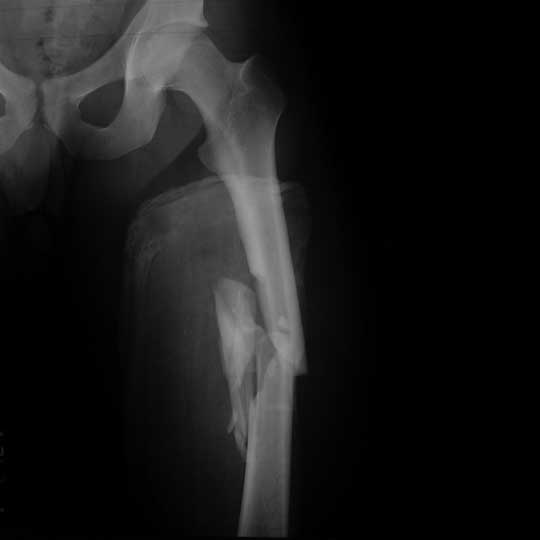synonyms: femoral intramedullary nail, femur IM nail
Retrograde Femoral Nail CPT
Retrograde Femoral Nail Indications
- Obesity
- Multi- trauma
- Ipsilateral femur/tibia fractures
- Ipsilateral femur/femoral neck fractures
- Ipsilateral femur/acetabulum
- Bilateral femur fractures
- Associated spine trauma
- Pregnancy
Retrograde Femoral Nail Contraindications
- Knee sepsis
- Knee soft tissue injury
- <45 knee ROM
Retrograde Femoral Nail Alternatives
Retrograde Femoral Nail Pre-op Planning
- Proximal portion of the nail must be above the lesser trochanter to avoid creating a stress riser.
- Cadaver studies show risk to femoral A. extremely low if prox A\P screw is placed above lesser trochanter.
- Use Synthes femoral distractor if axially unstable to maintain length.
- Current research does not show an increased incidence of lung complications with reamed nailing (Anwar IA, CORR 2004;422:71).
- Reamed nailing increases union rates and decreases time to union (Bhandari M, JOT 2000;14:2).
Retrograde Femoral Nail Technique
- Sign operative site.
- Pre-operative antibiotics.
- General endotracheal anesthesia
- Supine position on radiolucent OR table. Bump under hip. All bony prominences well padded.
- Examination under anesthesia of ipsilateral knee.
- Ensure adequate A/P and lateral c-arms of the hip, fracture and knee can be obtained.
- Prep and drape in standard sterile fashion.
- Midline patellar incision, patella to tib tubercle, split patellar tendon, excise fat pad as needed.
- Guide pin placed 1cm anterior to PCL origin. Varify placement with c-arm.
- Drill / ream entry hole
- Longitudinal traction usually sufficient for reduction,
- If reduction is unsatisfactory: femoral distractor-5mm schanz pin; proximal intertroch/lateral femoral condyle, pins placed slightly posterior.
- Pass guidewire across fracture site under c-arm guidance.
- Ream sequentially. Generally ream to 1 or 1.5mm larger than the width at which cortical chatter was achieved.
- Measure nail length. Nail should end proximal to lesser troch to avoid subtroch stress riser. Nail width should be 1 or 1.5mm narrower that the last reamer used.
- Place nail
- Locked distally
- Evaluate leg length and alignment. Make any adjustments necessary. Leg can be lengthened by using slap hammer.
- Lock nail proximally.
- Consider placing end cap distally to avoid risk of hemarthrosis.
- Evaluate knee ROM and ligamentous stability
- Evaluate femoral neck for occult fracutre with C-arm
- Evaluate thight and leg for compartment syndrome
- Irrigate.
- Close in layers.
Retrograde Femoral Nail Complications
- Infection-0.9%
- Nonuion=0.9%
- Malunion(rotation,shortening,angulation) rotational difference > 15 degrees from unaffected side is a true malrotation deformity. Hip and knee symptoms and functional disability occur when rotation is >20 degrees. Rotational differences <10 degrees seldom produce symptomatic disability.
- Peroneal nerve palsy
- Fat-embolism sydrome
- ARDS
- DVT / PE
- Pudendal Nerve palsy: compression of the pudendal nerve from traction against the perineal post on the fracture table in the supine position can lead to perineal numbness following intramedullary nailing. Attention to detail in placement of the patient and adequate padding can minimize this risk. (Brumback RJ,.JBJS 1992;74A:1450-1455)
- DIC
- Compartment Syndrome
- Heterotopic Ossification
- Knee pain (retrograde nail)
- Thigh pain (antegrade nail)
- Abductor lurch (antegrade nail)
Retrograde Femoral Nail Follow-up care
- Post-op: Toe-touch weight bearing depending on fracture configuration. Consider weight bearing as tolerated for short oblique or transverse fractures with 100% cortical contact. Evaluate post-op xrays. Knee ROM exercises.
- 7-10 Days: Dressing change. Post-op A/P and lateral femur xrays. Continue toe-touch weight bearing. Consider weight bearing as tolerated for short oblique or transverse fractures with 100% cortical contact. Knee ROM exercises
- 6 Weeks: Post-op A/P and lateral femur xrays. Advance to full wieght-bearing when bridging callus is visible on two orthogonal xrays. Evaluate Knee ROM. Consider PT if knee ROM is poor. Consider nail dynamization if minimal fracture callus is seen in stable fractures.
- 3 Months: Post-op A/P and lateral femur xrays. Consider nail dynamization if minimal fracture callus is seen in stable or unstable fractures.
- 6 Months: Post-op A/P and lateral femur xrays. Assess fracture callus. May return to non-contact sports.
- 1Yr: Post-op A/P and lateral femur xrays. Evaluate outcomes.
Retrograde Femoral Nail Outcomes
- 6% nonunion, Union at 12.6 weeks, Excellent knee function with minimal knee pain. (Moed B, JOT 1998;12:334).
Retrograde Femoral Nail Review References
- Rockwood and Greens°
- Moed BR, JAAOS 1999;7:209



